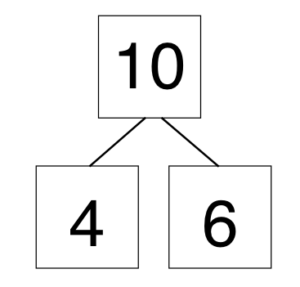A teacher recently asked me a question: “What do I do with the student who is strong enough in his math concepts, but he has no idea about Singapore Math approaches like number bonds, and he starts our school late in the year?”
For her and other teachers in the same boat, I’m making this “cheat sheet,” which is targeted at elementary school children who start mid-year in Math in Focus or Primary Mathematics.
1. Number Bonds
Number bonds show the ways in which numbers relate to each other. They can also be thought of as “part-whole” pictures, in which you see two or more parts that make up a whole.
To catch a child up with these, you can try one of several things.
a) Sit with the child and a laminated number bond page, and write number bonds in them. Ask the child to create number sentences (equations) from the number bonds. Then have the child fill in the missing number in a number bond with a part, or the whole, missing.
Example:

Number sentences:
4 + 6 = 10
6 + 4 = 10
10 – 4 = 6
10 – 6 = 4
With practice, the child will realize that all these facts are related, and that subtraction starts with the whole minus one part, while addition is made of two parts forming a whole. I’ve found it can help students who are struggling with subtraction, especially with those problems missing the whole, for example _____ – 7 = 5. Rewriting these as a number bond can assist the child to see that the whole is what is missing, so she needs to add the two parts.
An article that explains number bonds more in depth can be found at Let’s Play Math.
b) Have the child play number bond games. One of the best I have found is called Number Bonds. It is available for both addition/subtraction and multiplication/division. See my review of these games here.
c) Play other games that involve number bonds. Addition War and Subtraction War, which are outlined in this PDF, are both fun games children love. You can customize them to this need by having the student write the problems that turn up on the cards on a laminated number bond sheet with a dry-erase marker, which will show you how much the child understands about number bonds.
2. Model Drawing
Another feature of the Singapore approach to teaching math that is new to many US teachers in model drawing for problem solving. This is a powerful visual approach, and with practice, it becomes much faster than other ways of solving word problems.
A great resource to learn about model drawing is at thesingaporemaths.com. To practice free problems using the model drawing approach, head on over to thinkingblocks.com. There are also videos on that site that explain the approach, and free iPad apps are available for four different types of word problems here.
For a new student when you don’t have much time to give one-on-one attention, set her up on Thinking Blocks to help her understand how to use this.
3. Place value
The Singapore approach places a heavy emphasis on place value. Many other programs do too, but not all, so you may find this lacking in a new student.
Again, considering that teachers may be too busy to spend a lot of one-on-one time with students, I am providing several electronic resources to teach this.
a) NLVM has some good resources for teaching place value. They require Java to run and can be used on a computer or interactive white board, or you can download their app that doesn’t require Java. Here are links to:
- place value/base blocks addition
- place value/base blocks subtraction
- place value/base blocks addition & subtraction with decimals
b) Here is an Illuminations lesson plan to play a place value card game.
c) A good iPad app for modeling with place value blocks is Number Pieces.
d) If you do have the time, make your own place value chart and use money or place value blocks to represent tens, ones, and other places your student may be learning. This will help a great deal with his number sense.
That wraps it up for this article, but if you have other questions, suggestions or issues, please let me know in the comments, and I’ll update the article as needed. Thanks for reading!



My district is looking at these materials. I have concerns about differentiation and remediation. Does this program have any components to address these areas? Also am concerned about the amount of voting it requires!? Can you tell me more?
Hi Anita, thanks for asking these questions. I’m not sure about any voting the program requires. For differentiation and remediation, there are different resources, but it would be best to ask the company (which I do not represent) directly. Thank you!